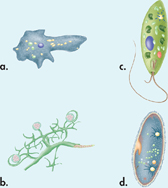21 Assessment
21.1 Protist Classification
Understand Key Concepts
Which of the following descriptions applies to most protists?
unicellular prokaryotes
multicellular prokaryotes
unicellular eukaryotes
multicellular eukaryotes
The fossil record shows that the first eukaryotes may have appeared on Earth
more than 4 billion years ago.
more than 1 billion years ago.
about 500 million years ago.
about 100 million years ago.
Which of the following statements is most accurate?
Protists are more closely related to one another than to other organisms in other kingdoms.
Protists are the direct descendants of bacteria.
The classification of protists is a work in progress.
Scientists are debating between two classification schemes for protists.
What is the problem with the traditional classification of protists into plantlike, animal-like, and funguslike groups?
Why do scientists think that all modern plants, animals, and fungi can be traced to protist ancestors?
Think Critically
Apply Concepts At one time, living things were classified as animals if they moved or ingested food and classified as plants if they did not move or ingest food. Why is it difficult to classify the protists by these criteria?
Use Analogies You might have a drawer in your kitchen that is a “junk drawer”: a drawer filled with keys, rubber bands, pens, string, rulers, and other items that aren't easy to categorize. How is the protist kingdom like a “junk drawer,” and why do you think scientists would like to change that situation?
21.2 Protist Structure and Function
Understand Key Concepts
Which is NOT true of amoebas?
They reproduce by mitosis.
They move using pseudopods.
They have a rigid cell membrane.
The protein actin powers their movement.
Which of the following protists moves by means of cilia?

Alternation of generations is the process of alternating between
mitosis and meiosis.
asexual and sexual reproduction.
male and female reproductive structures.
diploid and haploid phases.
What function do the cilia and flagella in protists carry out? How do they differ in structure?
Summarize the process of conjugation. Is conjugation a form of reproduction? Explain.
Think Critically
Apply Concepts Some protists cannot move on their own. What generalization can you make about how these organisms survive?
Infer How do you think the ability to switch between asexual and sexual reproduction has aided the evolution of water molds and many other protists?
Table of Contents
- Formulas and Equations
- Applying Formulas and Equations
- Mean, Median, and Mode
- Estimation
- Using Measurements in Calculations
- Effects of Measurement Errors
- Accuracy
- Precision
- Comparing Accuracy and Precision
- Significant Figures
- Calculating With Significant Figures
- Scientific Notation
- Calculating With Scientific Notation
- Dimensional Analysis
- Applying Dimensional Analysis




